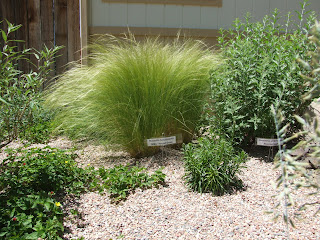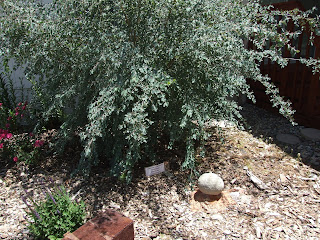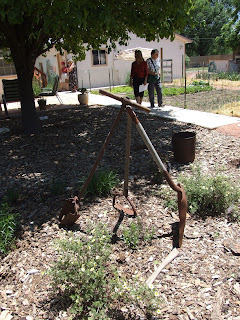The last stop was just wonderful. The hostess was so enthusiastic about planting and growing, and sharing what she has learned in the ten years she has lived in this house and fought with the severe growing conditions. The house sits slightly higher than others nearby, is surrounded by prairie and is a vision as you approach it.

This is from the road. You can see there is no real division between the natural prairie and the landscaped garden, except for three inches of bark mulch that covers the yard.

Going up the driveway, you can see a sculpture that was loaned for the tour. It is carved cement.

This picture and the next two are a panorama of the back yard. This one looks toward the road.

This one is straight into the back of the house. There is a little more variety of color here with yucca, salvias, and something red, maybe Jupiter's Beard.

This one is looking toward to north edge of the yard.

Looking east on the north side of the yard, this is the back of the house.

This view is stepping around on the north side of the house, and shooting toward the west and south. Of course, you can see other houses, but there is still a feeling of isolation. Prairie vegetation is in the foreground. Red bushes define the parameter of the yard.

Moving around and turning toward the front entry of the house, you see this bed that is elevated off the driveway along the east side. At the right side of the picture you can just see the piles of gravel and mulches that are added to the gardens as needed to keep the mulch three inches deep.

The front entry way that faces east. Behind the wall is a lovely courtyard with a pool and an exuberant standard french poodle puppy.
The owner/gardner has taken the master gardner classes and found them very valuable. When she started landscaping about ten years ago she covered the yard with weed barrier and a finely crushed rock called "breeze" and after a couple of years realized that her plants were not doing well. She found out the barrier fabric and rock were smothering the soil, not letting oxygen into it, so she removed all of it and the plants just took off! She said she was so excited when she finally began finding earthworms in the soil again!
She has found that Zone 5 plants do not do well in her yard, so plants only Zone 4 and down. She gets most of her plants from Blue Stone Perennials in Ohio. She waters her established plants twice a month for 20 minutes, using soaker hoses and sometimes sprinkers. New plants get water once a week until they become established. She told me when she plants something she tells the plant, "I have done all I can do, now you either grow or you die!"
Her reference 'bible' is a book put out by the Denver Water Board called "Companion Plantings".
For local places to get plants she especially likes Brady's in Canon City which has exotic drought tolerant perennials, Apple Valley in Penrose which is a wholesale operation, Siefers in Canon City for drought tolerant plants and knowledgable people and Palace Nursery which is located behind Safeway in Pueblo West for nice pereinnials and knowledgable people.

One last look at the gardens on the way out. An extremely nice lady who likes to share her knowledge. She highly recommends the master gardners classes.
 This is from the road. You can see there is no real division between the natural prairie and the landscaped garden, except for three inches of bark mulch that covers the yard.
This is from the road. You can see there is no real division between the natural prairie and the landscaped garden, except for three inches of bark mulch that covers the yard.
 Going up the driveway, you can see a sculpture that was loaned for the tour. It is carved cement.
Going up the driveway, you can see a sculpture that was loaned for the tour. It is carved cement.
 This picture and the next two are a panorama of the back yard. This one looks toward the road.
This picture and the next two are a panorama of the back yard. This one looks toward the road.
 This one is straight into the back of the house. There is a little more variety of color here with yucca, salvias, and something red, maybe Jupiter's Beard.
This one is straight into the back of the house. There is a little more variety of color here with yucca, salvias, and something red, maybe Jupiter's Beard.
 This one is looking toward to north edge of the yard.
This one is looking toward to north edge of the yard.
 Looking east on the north side of the yard, this is the back of the house.
Looking east on the north side of the yard, this is the back of the house.
 This view is stepping around on the north side of the house, and shooting toward the west and south. Of course, you can see other houses, but there is still a feeling of isolation. Prairie vegetation is in the foreground. Red bushes define the parameter of the yard.
This view is stepping around on the north side of the house, and shooting toward the west and south. Of course, you can see other houses, but there is still a feeling of isolation. Prairie vegetation is in the foreground. Red bushes define the parameter of the yard.
 Moving around and turning toward the front entry of the house, you see this bed that is elevated off the driveway along the east side. At the right side of the picture you can just see the piles of gravel and mulches that are added to the gardens as needed to keep the mulch three inches deep.
Moving around and turning toward the front entry of the house, you see this bed that is elevated off the driveway along the east side. At the right side of the picture you can just see the piles of gravel and mulches that are added to the gardens as needed to keep the mulch three inches deep.
 The front entry way that faces east. Behind the wall is a lovely courtyard with a pool and an exuberant standard french poodle puppy.
The owner/gardner has taken the master gardner classes and found them very valuable. When she started landscaping about ten years ago she covered the yard with weed barrier and a finely crushed rock called "breeze" and after a couple of years realized that her plants were not doing well. She found out the barrier fabric and rock were smothering the soil, not letting oxygen into it, so she removed all of it and the plants just took off! She said she was so excited when she finally began finding earthworms in the soil again!
She has found that Zone 5 plants do not do well in her yard, so plants only Zone 4 and down. She gets most of her plants from Blue Stone Perennials in Ohio. She waters her established plants twice a month for 20 minutes, using soaker hoses and sometimes sprinkers. New plants get water once a week until they become established. She told me when she plants something she tells the plant, "I have done all I can do, now you either grow or you die!"
Her reference 'bible' is a book put out by the Denver Water Board called "Companion Plantings".
For local places to get plants she especially likes Brady's in Canon City which has exotic drought tolerant perennials, Apple Valley in Penrose which is a wholesale operation, Siefers in Canon City for drought tolerant plants and knowledgable people and Palace Nursery which is located behind Safeway in Pueblo West for nice pereinnials and knowledgable people.
The front entry way that faces east. Behind the wall is a lovely courtyard with a pool and an exuberant standard french poodle puppy.
The owner/gardner has taken the master gardner classes and found them very valuable. When she started landscaping about ten years ago she covered the yard with weed barrier and a finely crushed rock called "breeze" and after a couple of years realized that her plants were not doing well. She found out the barrier fabric and rock were smothering the soil, not letting oxygen into it, so she removed all of it and the plants just took off! She said she was so excited when she finally began finding earthworms in the soil again!
She has found that Zone 5 plants do not do well in her yard, so plants only Zone 4 and down. She gets most of her plants from Blue Stone Perennials in Ohio. She waters her established plants twice a month for 20 minutes, using soaker hoses and sometimes sprinkers. New plants get water once a week until they become established. She told me when she plants something she tells the plant, "I have done all I can do, now you either grow or you die!"
Her reference 'bible' is a book put out by the Denver Water Board called "Companion Plantings".
For local places to get plants she especially likes Brady's in Canon City which has exotic drought tolerant perennials, Apple Valley in Penrose which is a wholesale operation, Siefers in Canon City for drought tolerant plants and knowledgable people and Palace Nursery which is located behind Safeway in Pueblo West for nice pereinnials and knowledgable people.
 One last look at the gardens on the way out. An extremely nice lady who likes to share her knowledge. She highly recommends the master gardners classes.
One last look at the gardens on the way out. An extremely nice lady who likes to share her knowledge. She highly recommends the master gardners classes.
























